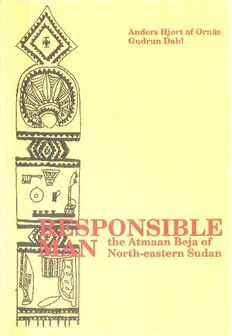
Responsible man: The Atmaan Beja of North-eastern Sudan PDF
Preview Responsible man: The Atmaan Beja of North-eastern Sudan
Anders Hjort af Ornäs Gudrun Dahl ~-PONSIBLE the Atmaan Beja of North-eastern Sudan RESPONSIBLE MAN the Atmaan Beja of North-eastern Sudan Anders~jortafOrnäs GuilrunDahl NORDISKA AFRIKAINSTITUTET j~!:ll -09- 1 6 UPPSALA Publishedby StockholmStudies inSocialAnthropology, SSSA incooperationwith Nordiska Afrikainstitutet, Uppsala 1991 Cover:ThetopofawoodenBejacomb,usedbymento embellishtheirAfro stylehair.Thefigureintheuppersectionisa man'shead. Themiddle sectionshowsanumberofutensilsusedinthe coffeeceremony:fan, stove andsetofjabanapotandcups.Totherightoftherineinthebottomsection isa pack-sackfor a camel. DrawingsbyGudrunDahl Typesetting:KerstinEdlund,UppsalaUniversity,Uppsala ISBN91-7146-905-2 ©AndersHjortafOrnäs,GudrunDahl, 1991 PrintedinSwedenby Reklam& Katalagtryck, Uppsalauniversitet, 1991 Contents Preface viii Sometermsusedin thetext ix 1. TheAtmaanAmar'arandtheircountry Theareaanditsinhabitants l Anoutlineofthestudy 8 2. FromtheRedSeatotheNileValley: Anhistorical backgroundtotheBeja'sresourcesituation 13 TheoriginsofBejaeconomy 15 Desertroutes,harboursandearlytrade 20 TheBejaandtheHadariba 22 Bejagroupsinthe19thcentury 29 Egyptianrule 31 HarboursandroutesduringtheTurko-Egyptianera 33 OsmanDignaandtheBeja:slavetradereligionandwars 35 TheBritishimpactontheAtmaanandotherBeja 38 Conc!usion 41 3. Territory,resourcecontroiandsolidarityamongtheAtmaan 45 Thelineagesystem,afolkmodelofhistoricaliinks 49 Diwabideologyandlivestockproperty 55 Physicalandsocialterritory 57 Urbanresourcesanddiwabstructure 62 Territoriality,kinshipandneighbourhood 64 4. The responsibleman 69 Keymalevirtues 70 Honourasacol1ectiveresource 75 Leadershipandarbitration 82 Managementofhonourinamixedculturalenvironment 84 Reflectionsdnhospitality,al1ianceandhierarchy 88 v 5. Gender roles,marriageand brother-sisterrelations 91 _ Insideandoutside 91 Brotherhoodandmarriage 92 Genderandwork 98 Womanhoodandmarriage 102 Thelimitedsignificanceofmarriage 107 6. Gettinggrain 109 Farmlandandthequestionofownership 112 Thecu1tivationprocess 117 Thelocalgraintradeversustheworldmarket 122 7. Familyherds 127 Thecame1inloca1life 128 Thecame1population 132 Threepattemsofcame1pastoralism 134 Aririitcame1pastoralisminAulib 134 Matiaatcame1pastoralisminthekhors 136 Shallageeacame1pastoralismonthecoast 137 Smallstockherding 139 Shepherding:productionandvu1nerability 142 Changeandconstraints 146 8. The dwindIingresource base 151 ThemodernhistoryofdroughtinBejalands 152 TheSanasitaperiod1888-89 154 Environmentalhazardsduringthepost-Sanashaperiod 156 AsummaryofgeneraltrendsinlandcontroibytheBeja 162 Thescopeoflocalobservation 164 Treesandpoverty 168 Talkingaboutdisaster 172 GodandtheBeja'snewneighbours 173 Unificationanddivision 175 Appendix: Early Heja history 177 Bejacountry<UldNubiainancienttimes 177 TheBejainEar1yArabtimes 180 HibIiography 185 vi Maps 1. North-eastemSudan 6 2. TheBejaandotherCushiticgroups 16 3. TheRedSeainc1assicaltimes,andsomeplacesmentionedinthetext 19 4. CaravanroutesofsignificancefortheBeja 24 5. ThecoreareaofAtmaantraditionalrightsandsettlements 47 6. CatehmentareasinRedSeaProvince 113 7. Naturalvegetationinnorth-eastemSudan 114 Figures 1. Amar'argroupsandsubdivisions 48 2. GenealogiesoftheAtmaanrecordedin1935and1980 51 vii Preface This study is based on fieldwork carried out during different periods. The authors spentfive monthseachinRed SeaProvince in 1980.Hjort af Ornäs returned for a two-month period later that year. Dahl spent two months there in 1986/87. Inview ofthe methodological problems involved in studying the Beja, we would have preferred to have spent more time in the field than has for personal reasons been possible for us. As aconsequence, the presentvolumeis as muchbuilton reviewing the availablewrittensources onthe Bejaas onfield data, and itis more exploratory in nature than conc1usive. Nevertheless, we hope that the present volume will contribute to identifying interesting fields for further research among the Beja. Our fieldwork was carried out mainly among the Atmaan, who constitute the major part of the Atmaan-Amar'ar, with families centered on Waheda (outside Port Sudan), Musmar and Ariaab. Our own field data apply to them but, particularly in the chapters on history and onrecentchanges inthe resourcebasis,we have had an eye to the broader region ofthe northern Beja in general. It is difficultfor us to judge the extent to which the people we have been dealing with are more Arabicized than the Beja living at greater distances from the main routes, but our impression is that various groups ofHadendowa, Atmaan-Amar'ar and Bishariin have enough in common to be treated as one singleculture. The work has been financed by SAREC (the Swedish Agency for Research Cooperationwith Developing Countries) and by the Swedish Academy ofScience. Their contribution is gratefully appreciated, as is also the assistance of many Beja friends. This has to be a collective acknowledgement. Among individuals we wish to thank are Waffa Osman and Ali Salah ofSudan CentralRecords Archives, Safia ofthe Anthropology and Sociology Department, Peter Walker, Nicholas Meadows, Penny Nestle and Suzanne Quinney. Thanks also to M A Mohamed Salih for his comments on the early draft ofthis book. The language editing was done by Tim Caudery and the maps were drawn by Peter van Gylswyck. Typesetting, finally, was executed by Kerstin Edlund. Anders HjortafOrnäs and Gudrun Dahl viii Some Beja terms used in the text Please note that this list is primarily prepared to help the reader with tenns used in the text. This means not least that many tuBedawiet words are listedhere with the masculine orfeminine prefix. Ababda the mostnorthem ofthe Beja groups adarharob red durra 'adlib Suaedafruticosa Forsk., abush amab Tamarix aphyllaformakingwoodenpoles angareb ropebed aririit type ofcamel: fairmilk producers. Main advantage is endurance asl customarytitle to land Atmaan aBeja group ayb taboo balat'harob durrawhichis identicalwith himeisi,Stapfvariety balbal weeds Bedawiet Beja Beni Amer (Khasa) ethnic group withlinks to the Beja and theTigre, butethnically distinctfrom both billtub dukhn (Ar.); finger millet Bishariin aBeja group dameini to cover dayb ground pits for durra dekab a shelteroftimberfor givinghospitality andholdingcouncils diwab majorclan group dukhn (Ar.) finger millet durareit honour (n) feddan measure ofland area. l feddan = 1.038 acres gangar durra cob gefareeb Salsolabaryosmaabush,camelfodder gudamantib development gwadabb symbolic recognitionoflandownership; front legofanimal hadara civilization hadarenini tobehospitable Hadendowa aBejagroup halagen bride-wealth ix harob durra (Ar.); sorghurn hedareb hospitablepeople i'damar thepermanenthomeplace i'mara rights; the rights obtainedinexchangefor thegwadabb jabana Turkishcoffee jawal 90kg sackofdurra kantar l smallkantaris 44.928 kg. Forcotton, abig kantar is 141.523 kg. kirrab a watercatchment kurai the grazing territory to which aBeja c1aims customary rights matiaat thefastest andmostslenderofthe Atmaancamels mish'ariib camelherder mugud a durra type mushuk date residue from wine production nandab shadetree o'di smoke-bath o'mkir the act ofconsulting an elderofone ofthe property-holding diwab o'slif customarylaw o'tam durra porridge omda lowerlevel"headmen" qalla work ganginport qole the distance aland-ownercanthrow his walking stick rafig (Ar.), a sponsorto vouch for one's goodfaith rattel 1rattel is approximately 0,45 kg (various sources indicate 7.25 rattel =3.5 kg; 100rattel =44.928 kg, and 1kg = 2.25 rattel) safiia 1safiia=15.14litres Sanasita 1888-89droughtdisaster shallageea type ofcamel: the sturdiestand thebestmilkproducers sheikh leaderinthekinship system butalso aQuranicteacher shetariit (Ar. fetarita); seeharob shuush Panicum turgidumperennialgrass; excellentcamelfodder si/sila alinealchainofreligioussuccession suganneit insult,provocation againstcollectivehonour sulh property rights to land sumatu individualreputation t'angash (Ar. saluka) adiggingstick t'anna sheep tajjer compensationingoldormoney x ti'hibqualda seematiaat ti'sagane Acaciaspirocarpa ti'smaya namegiving Tu'Durarey orsynonymously o'rya: honour tubahala the (dry) periodlastingfromNovemberto March TuBedawiye theBejalanguage tuhoobi rainy period wahalas the afterbirth yategaab shepherd yomiia a day's work inport xi
